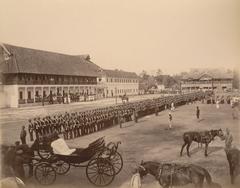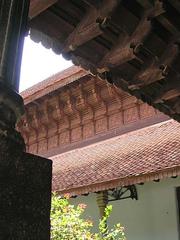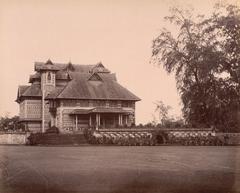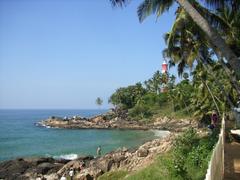A Complete Guide to Visiting Aruvikkara Dam
Date: 18/07/2024
Introduction
Aruvikkara Dam is not just an engineering marvel but also a cultural and recreational hub. It attracts a multitude of visitors each year, drawn by its scenic beauty, lush gardens, and tranquil ambiance. The area around the dam has evolved into a popular tourist destination, offering a range of recreational activities such as boating and trekking. Furthermore, the nearby Aruvikkara Devi Temple adds a layer of cultural significance, making it a site of spiritual importance as well. This comprehensive guide aims to provide detailed insights into the history, significance, and visitor information for the Aruvikkara Dam, ensuring a memorable experience for all who visit.
Table of Contents
- Introduction
- History and Significance
- Visiting Hours and Tickets
- Beyond Water - A Multifaceted Asset
- Nearby Attractions
- Symbol of Progress and Sustainability
- Looking Ahead - A Sustainable Future
- Visitor Information
- Environmental and Societal Impact
- Sustainable Tourism and Conservation Efforts
- Responsible Tourism Practices for Visitors
- Conclusion
- FAQ
- Call to Action
Visiting Aruvikkara Dam - History, Significance, Tickets, and Travel Tips
The Aruvikkara Dam stands as a testament to the foresight and engineering prowess of a bygone era. Constructed in 1953, during the reign of King Chithira Thirunal Balarama Varma, the dam marked a significant step in Thiruvananthapuram’s journey towards self-sufficiency in water supply.
Early Days and Purpose
The dam’s construction was driven by the pressing need to address the water scarcity issues plaguing Thiruvananthapuram, especially during the summer months. The then-ruler, recognizing the gravity of the situation, commissioned the dam’s construction on the Karamana River. This ambitious project aimed to harness the river’s waters, creating a reservoir capable of meeting the city’s burgeoning water demands.
Engineering and Design
Built primarily with rubble masonry, the Aruvikkara Dam stands as a testament to the robust construction techniques of the time. It rises to a height of 79 feet (24 meters) and stretches 1022 feet (312 meters) in length, creating an impressive barrier against the flow of the Karamana River. This structure effectively impounds a significant volume of water, forming the Aruvikkara Reservoir, a vital source of water for Thiruvananthapuram.
Water Supply and Irrigation
From its inception, the Aruvikkara Dam has played a pivotal role in quenching the thirst of Thiruvananthapuram’s residents. The reservoir it creates serves as a primary source of drinking water for the city, ensuring a reliable supply even during periods of low rainfall. Beyond its role in urban water supply, the dam also extends its benefits to the agricultural sector. Its waters are channeled through an intricate network of canals, irrigating vast swathes of agricultural land in its vicinity. This irrigation network has been instrumental in boosting agricultural productivity, contributing significantly to the region’s economic prosperity.
Visiting Hours and Tickets
The Aruvikkara Dam is open to visitors throughout the year. The visiting hours are generally from 9 - 00 AM to 5 - 00 PM. There is no entry fee for visiting the dam, making it an accessible destination for everyone. However, it is always a good idea to check for any updates or changes in timings before planning your visit.
Beyond Water - A Multifaceted Asset
While the Aruvikkara Dam’s primary function is water management, its significance extends far beyond this utilitarian role. Over the years, the dam and its surrounding areas have evolved into a popular tourist destination, attracting visitors with their scenic beauty and tranquil ambiance.
A Tourist’s Paradise
The dam’s picturesque location, nestled amidst rolling hills and verdant greenery, makes it a visual treat for nature enthusiasts. The serene waters of the reservoir, reflecting the azure sky, create a captivating sight, offering a sense of peace and tranquility. Adding to the allure are the lush gardens that adorn the dam’s surroundings. These meticulously maintained gardens, bursting with vibrant flora, provide a welcome respite from the city’s hustle and bustle. Visitors can stroll through these verdant spaces, immersing themselves in the beauty of nature.
Recreation and Leisure
The Aruvikkara Dam and its environs offer ample opportunities for recreation and leisure. Boating facilities are available at the reservoir, allowing visitors to glide across the placid waters, soaking in the scenic vistas. The surrounding hills, cloaked in verdant vegetation, provide excellent trekking trails for adventure enthusiasts.
Cultural Significance
The Aruvikkara Dam is not just a marvel of engineering but also a place of cultural significance. Located near the dam is the renowned Aruvikkara Devi Temple, dedicated to Goddess Durga. This ancient temple, steeped in history and legend, attracts devotees and tourists alike.
Nearby Attractions
In addition to the Aruvikkara Dam, Thiruvananthapuram boasts several other historical sites worth visiting. The Padmanabhaswamy Temple, Napier Museum, and Kovalam Beach are just a few of the attractions that can complement your visit to the dam.
A Symbol of Progress and Sustainability
The Aruvikkara Dam stands as a symbol of progress and sustainable development. It showcases how infrastructure projects can be seamlessly integrated with the natural environment, providing essential services while preserving the ecological balance. The dam’s enduring legacy lies in its ability to cater to the needs of the present without compromising the ability of future generations to meet their own needs.
Conservation Efforts
Recognizing the importance of preserving this vital resource, authorities have undertaken various conservation efforts around the Aruvikkara Dam. These initiatives focus on maintaining the ecological balance of the surrounding areas, ensuring the dam’s longevity and the sustainability of the services it provides.
Afforestation Programs
Extensive afforestation programs have been implemented in the catchment area of the dam. These programs aim to increase the green cover, which plays a crucial role in regulating water flow, preventing soil erosion, and enhancing the biodiversity of the region.
Water Quality Monitoring
Stringent water quality monitoring mechanisms are in place to ensure the purity of the water stored in the reservoir. Regular testing is conducted to detect any potential contaminants, and appropriate measures are taken to maintain the water’s potability.
Community Involvement
Local communities play an active role in the conservation efforts around the Aruvikkara Dam. They participate in awareness programs, tree plantation drives, and other initiatives aimed at protecting the environment and promoting sustainable practices.
Looking Ahead - A Sustainable Future
The Aruvikkara Dam, with its rich history and enduring significance, continues to play a vital role in the lives of Thiruvananthapuram’s residents. As the city grows and evolves, the dam’s importance as a source of water and a place of recreation and cultural significance remains undiminished. With ongoing conservation efforts and the support of local communities, the Aruvikkara Dam is poised to continue its legacy of sustainable development, serving as a lifeline for generations to come.
FAQ
Q - What are the visiting hours of Aruvikkara Dam? A - The dam is open from 9 - 00 AM to 5 - 00 PM throughout the year.
Q - Is there an entry fee for Aruvikkara Dam? A - No, there is no entry fee for visiting the dam.
Q - Are guided tours available at Aruvikkara Dam? A - Guided tours are not typically available, but visitors can explore the dam and its surroundings at their own pace.
Call to Action
For more updates and information about Aruvikkara Dam and other historical sites in Thiruvananthapuram, download the Audiala mobile app. Follow us on social media for the latest news and travel tips.
Aruvikkara Dam - Visitor Information, Historical Significance, and Attractions in Thiruvananthapuram
Introduction
Nestled in the heart of Thiruvananthapuram, Aruvikkara Dam is a must-visit destination that offers a blend of natural beauty, historical significance, and a variety of recreational opportunities. Whether you’re a history enthusiast, nature lover, or adventure seeker, Aruvikkara Dam has something to offer everyone.
The Dam and Reservoir
The central attraction is undoubtedly the Aruvikkara Dam itself. Constructed across the Karamana River, the dam’s imposing structure is a sight to behold, especially during the monsoon season when water cascades down its spillway. The reservoir formed by the dam offers picturesque views, surrounded by lush greenery. Visitors can enjoy a leisurely stroll along the dam’s top, taking in the panoramic vistas of the water and the surrounding landscape.
Aruvikkara Park
Adjacent to the dam lies the well-maintained Aruvikkara Park, a popular spot for families and picnickers. The park features beautifully landscaped gardens, children’s play areas, and ample space for relaxation. The park’s serene ambiance, coupled with the cool breeze from the reservoir, makes it an ideal escape from the city’s hustle and bustle.
Neyyar Dam and Lion Safari Park
A short drive from Aruvikkara Dam takes you to the Neyyar Dam, another scenic reservoir area. Here, visitors can enjoy boating facilities and explore the Neyyar Lion Safari Park. The park is home to a variety of animals, including lions, deer, and various bird species. A visit to Neyyar complements the Aruvikkara experience, offering a wildlife adventure in close proximity.
Agasthyamalai Hills
For the adventurous, the Agasthyamalai Hills, part of the Western Ghats, loom in the distance, offering trekking opportunities. These hills are known for their rich biodiversity and stunning views. However, trekking in this region often requires permits and should be undertaken with proper planning and guidance from local authorities.
Temples and Cultural Sites
Aruvikkara is also home to several temples and cultural sites. The ancient Aruvikkara Devi Temple, dedicated to Goddess Durga, is a significant pilgrimage site. Located near the dam, the temple attracts devotees throughout the year, especially during festivals like Navaratri. The temple’s architecture and spiritual significance add a cultural dimension to the Aruvikkara experience.
Kathakali Performance at Kerala Kalamandalam
While not directly at Aruvikkara, a visit to Kerala Kalamandalam, a renowned arts academy located about an hour away, can enrich your cultural experience. Witnessing a traditional Kathakali performance, with its elaborate costumes, expressive makeup, and captivating storytelling, is a must-do when in Kerala.
Visitor Information
To make the most of your visit to Aruvikkara Dam, here are some essential visitor tips -
- **Best Time to Visit - ** The ideal time to visit Aruvikkara Dam is during the post-monsoon season (October to March) when the weather is pleasant and the reservoir is full.
- **Timings and Entry Fees - ** The dam and park are open throughout the week. Entry fees may apply, and it’s advisable to check the latest timings and fees from official sources before your visit.
- **Getting There - ** Aruvikkara Dam is well-connected by road. You can hire taxis or take local buses from Thiruvananthapuram city to reach the dam.
- **Accommodation - ** While there are limited accommodation options near the dam, Thiruvananthapuram city offers a wide range of hotels and guesthouses to suit different budgets.
- **Food and Drinks - ** Several small eateries and restaurants near the dam and park offer local Kerala cuisine. It’s advisable to carry water bottles, especially if you plan to spend a significant amount of time outdoors.
- **What to Wear - ** Comfortable clothing and footwear are recommended, especially if you plan to walk around the dam or visit the park.
- **Respect Local Customs - ** When visiting temples and cultural sites, dress modestly and be mindful of local customs and traditions.
- **Photography - ** Photography is generally allowed at the dam and park. However, it’s always a good practice to ask for permission before taking pictures of people, especially in religious places.
FAQ Section
Q - What are the visiting hours for Aruvikkara Dam?
A - The dam and park are generally open from 9 - 00 AM to 5 - 00 PM, but it’s best to check with local sources for the most current information.
Q - How much are the tickets for Aruvikkara Dam?
A - Entry fees vary and should be confirmed from official sources prior to your visit.
Q - Are there guided tours available?
A - Guided tours are not commonly available, but local guides can sometimes be hired for a more in-depth experience.
Q - Is parking available at the dam?
A - Yes, there is parking available near the dam and park areas.
Conclusion
Aruvikkara Dam, with its scenic beauty, historical significance, and recreational opportunities, offers a memorable experience for visitors. Whether you seek tranquility amidst nature, a glimpse into Kerala’s cultural heritage, or an adventurous getaway, Aruvikkara has something to offer everyone. Don’t forget to check out other related posts and follow us on social media for more updates.
A Complete Guide to Visiting Aruvikkara Dam - Hours, Tickets, and History
Introduction
Nestled in the scenic landscapes of Thiruvananthapuram, the Aruvikkara Dam is not only a crucial water source but also a popular tourist attraction. This guide provides all the information you need for a memorable visit, from history and cultural significance to practical tips and unique experiences.
Environmental and Societal Impact
Ecological Significance
Aruvikkara Dam and its surrounding reserve forest play a crucial role in the local ecosystem. The reservoir serves as a vital source of water for irrigation and drinking water supply to Thiruvananthapuram city and nearby areas. This consistent water source supports agricultural activities and sustains the livelihoods of numerous farmers in the region.
The dam’s presence has also led to the creation of a unique microclimate, fostering a rich biodiversity hotspot. The Aruvikkara Reserve Forest, spanning over 5.14 sq km, is home to a diverse range of flora and fauna. This includes endangered species like the Nilgiri Tahr, Lion-tailed Macaque, and the Indian Giant Squirrel. The forest also boasts a variety of medicinal plants and serves as a natural habitat for numerous bird species, making it a haven for birdwatchers and nature enthusiasts.
Environmental Concerns
While the dam offers significant benefits, its construction and operation have also raised environmental concerns.
- **Deforestation and Habitat Loss - ** The creation of the reservoir resulted in the submergence of a large forested area, leading to habitat loss and fragmentation for various species. This displacement can disrupt ecological balance and impact the survival of sensitive species.
- **Water Quality - ** Agricultural runoff and untreated sewage from nearby settlements pose a threat to the water quality of the reservoir. Increased nutrient levels can lead to algal blooms, depleting oxygen levels and harming aquatic life.
- **Impact on Downstream Ecosystems - ** The dam’s regulation of water flow can alter the natural flow regime of the Karamana River, impacting downstream ecosystems and the communities that depend on them. Reduced water flow can affect fish migration patterns, riparian vegetation, and the overall health of the riverine ecosystem.
Social Impact
The Aruvikkara Dam has had a profound impact on the social fabric of the surrounding communities.
- **Displacement and Resettlement - ** The construction of the dam in the 1970s led to the displacement of several tribal communities who were dependent on the forest for their livelihoods. While resettlement efforts were undertaken, the process was not without its challenges, and some communities still face issues related to land rights and access to resources.
- **Economic Opportunities - ** The dam has created employment opportunities in areas like dam maintenance, tourism, and related services. The influx of tourists has also boosted the local economy, supporting small businesses and providing income-generating opportunities for local communities.
- **Improved Living Standards - ** The dam’s role in providing a reliable water supply has significantly improved the living standards of people in Thiruvananthapuram and surrounding areas. Access to clean drinking water has positive implications for public health and sanitation.
Sustainable Tourism and Conservation Efforts
Recognizing the environmental and social significance of the Aruvikkara Dam, various initiatives are underway to promote sustainable tourism and conservation efforts.
- **Eco-Tourism Initiatives - ** The Kerala Forest Department has implemented eco-tourism programs in the Aruvikkara Reserve Forest, offering guided treks and nature trails that allow visitors to experience the region’s biodiversity while minimizing their impact.
- **Waste Management - ** Efforts are being made to improve waste management practices in and around the dam site to reduce pollution and protect the environment. Visitors are encouraged to dispose of waste responsibly and support local initiatives promoting cleanliness.
- **Community Engagement - ** Engaging local communities in conservation efforts is crucial for long-term sustainability. Initiatives that involve local communities in decision-making processes, provide training on sustainable practices, and offer alternative livelihood opportunities are essential for balancing conservation goals with the needs of the people.
Visitor Information
**Opening Hours - ** 9 AM - 5 PM
**Ticket Prices - ** Adults - $5, Children - $2
**Best Time to Visit - ** November to February
**How to Get There - ** Accessible by car or public transport from Thiruvananthapuram city center.
Travel Tips
**What to Bring - ** Comfortable walking shoes, water bottle, sunscreen
**Nearby Attractions - ** Neyyar Wildlife Sanctuary, Kovalam Beach
**Accessibility - ** Wheelchair accessible paths and facilities available.
Responsible Tourism Practices for Visitors
Tourists visiting Aruvikkara Dam can contribute to minimizing their environmental impact and supporting sustainable tourism practices by following these guidelines -
- **Respect Wildlife and their Habitat - ** Observe wildlife from a safe distance and avoid making loud noises or disturbing their natural behavior. Refrain from littering and keep the surroundings clean.
- **Conserve Water - ** Be mindful of water usage, especially during dry seasons. Use water responsibly and avoid wasting this precious resource.
- **Support Local Businesses - ** Opt for locally owned accommodations, restaurants, and shops to contribute to the local economy and support sustainable tourism practices.
- **Minimize Plastic Usage - ** Carry reusable water bottles and bags to reduce plastic waste. Dispose of any plastic waste responsibly or carry it back with you for proper disposal.
- **Follow Designated Trails - ** Stick to designated trails and paths to avoid trampling on vegetation and disturbing wildlife habitats.
- **Learn and Respect Local Culture - ** Take time to learn about the local culture and traditions. Interact respectfully with local communities and support their efforts in preserving their heritage.
Conclusion
Visiting the Aruvikkara Dam offers a unique blend of natural beauty and historical significance. Don’t forget to follow our responsible tourism tips to help preserve this beautiful site. Download our mobile app Audiala for more travel guides and updates.
FAQ
Q - What are the visiting hours for Aruvikkara Dam?
A - The dam is open from 9 AM to 5 PM.
Q - How much is the entrance fee?
A - The entrance fee is $5 for adults and $2 for children.
Q - What is the best time to visit the dam?
A - The best time to visit is from November to February.
Q - Is the dam accessible via public transport?
A - Yes, it is accessible by car or public transport from Thiruvananthapuram city center.
Q - Are there any nearby attractions?
A - Yes, nearby attractions include Neyyar Wildlife Sanctuary and Kovalam Beach.
Conclusion
As Thiruvananthapuram continues to grow and evolve, the Aruvikkara Dam’s significance remains undiminished. It symbolizes progress, sustainability, and the harmonious integration of infrastructure with nature. With ongoing conservation efforts and the support of local communities, the Aruvikkara Dam is poised to continue its legacy of sustainable development, serving as a lifeline and a source of inspiration for generations to come.





